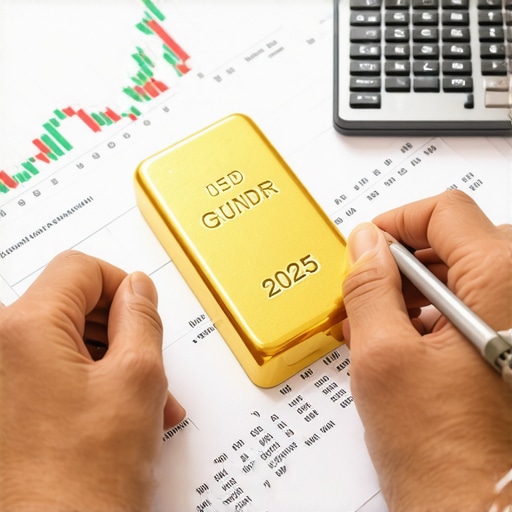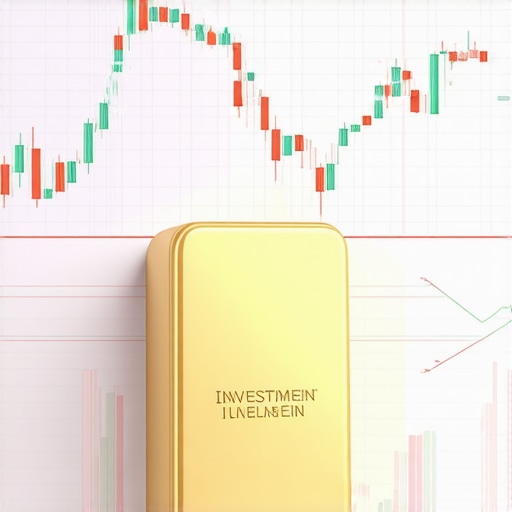Understanding the Complex Dynamics of Gold and Stock Markets in 2025
As we navigate the financial landscape of 2025, discerning the nuanced interplay between gold and equities requires a sophisticated analysis rooted in macroeconomic trends, geopolitical shifts, and technological innovations. Experienced investors recognize that optimizing wealth involves leveraging the unique attributes of these asset classes through strategic diversification, tactical timing, and an understanding of underlying supply-demand mechanics.
Why Gold Continues to Be a Vital Hedge in an Evolving Global Economy
Gold’s role as a safe-haven asset is reinforced by its intrinsic properties and its responsiveness to macroeconomic uncertainties. In 2025, with inflationary pressures driven by supply chain disruptions and fiscal stimulus measures, gold retains its appeal as an inflation hedge. Furthermore, central banks’ increasing accumulation of gold reserves — as detailed in this comprehensive report — signals institutional confidence that sustains long-term demand.
Advanced Equity Strategies for Wealth Growth in 2025
Equity investors are exploring thematic and quantitative strategies, emphasizing technology-driven sectors and ESG-compliant stocks. Top-performing sectors include artificial intelligence, green energy, and biotech, which are poised to capitalize on regulatory tailwinds and consumer shifts. Tactical allocation in gold mining stocks and innovative ETFs can amplify growth potential while managing volatility.
How can investors effectively balance gold and stocks to hedge against market volatility in 2025?
Expert investors recommend employing dynamic asset allocation models that adapt to macroeconomic signals. During periods of heightened geopolitical risk or inflation spikes, increasing gold holdings can preserve capital. Conversely, during economic expansion phases, equities offer higher growth potential. Developing a bespoke, data-driven strategy—integrating insights from demand cycle analysis—can optimize risk-adjusted returns.
Emerging Opportunities: Digital Gold and Alternative Assets
In addition to physical gold and stocks, 2025 presents opportunities in digital assets such as gold-backed tokens and innovative ETFs. These instruments offer liquidity and transparency advantages. Moreover, the expansion of gold-focused mutual funds and structured products can diversify portfolios and enhance passive income streams.
Future Outlook and Strategic Recommendations
Aligning with expert consensus, investors should develop a long-term, flexible plan that incorporates macroeconomic forecasts, technological advancements, and geopolitical developments. Regular portfolio rebalancing, combined with in-depth market analysis—supported by authoritative sources like the latest market reports—can ensure sustained wealth accumulation and resilience against unforeseen shocks.
Explore more advanced strategies and share your insights on gold and stock investments for 2025 by engaging with our expert community and staying informed through authoritative financial analyses.
Harnessing the Power of Diversification in 2025’s Uncertain Markets
As market dynamics continue to evolve, savvy investors recognize that a nuanced approach to diversification can be a game-changer. Combining physical gold assets with equity investments—particularly in emerging sectors—provides a resilient hedge against volatility. For example, implementing a tactical allocation strategy that adjusts exposure based on macroeconomic signals can optimize growth while preserving capital.
How Can Investors Leverage Data-Driven Insights to Maximize Wealth?
Utilizing advanced analytics and demand cycle analysis—detailed in this resource—allows investors to anticipate market shifts with greater precision. Integrating tools like predictive modeling and sentiment analysis can inform timely rebalancing decisions, especially when considering gold’s role as a hedge during inflationary surges or geopolitical tensions.
What innovative strategies can help investors stay ahead in the gold-stock relationship during 2025?
Expert investors are increasingly exploring thematic ETFs, gold mining stocks, and digital assets such as gold-backed tokens, which combine liquidity with diversification. As detailed in this comprehensive guide, these instruments enable passive income growth and risk mitigation, especially when aligned with long-term trends identified through market analysis.
Should Investors Consider Alternative Assets to Enhance Portfolio Resilience?
Beyond traditional gold and equities, alternative assets like structured products, real estate, and innovative commodities are gaining prominence. Incorporating these into a holistic portfolio—guided by insights from demand cycle analysis—can further safeguard against macroeconomic shocks and diversify income streams.
Engage and Expand Your Investment Horizons
To deepen your expertise, consider exploring our detailed resources on safe physical gold investments and secure gold buying practices. Share your experiences or ask questions in our community, and stay informed with the latest market analyses to craft a resilient investment portfolio for 2025 and beyond.
Integrating Quantitative Models for Optimal Asset Allocation in Uncertain Times
As macroeconomic variables become increasingly volatile, employing sophisticated quantitative models is essential for investors aiming to fine-tune their gold and stock allocations. Techniques such as Monte Carlo simulations, Bayesian inference, and machine learning algorithms enable the creation of dynamic, adaptive portfolios. For example, Bayesian models can incorporate real-time geopolitical and economic data to update asset weights instantaneously, thus providing a proactive rather than reactive investment stance.
According to a comprehensive study published by the CFA Institute, integrating these models enhances risk-adjusted returns by systematically capturing complex market signals that traditional methods might overlook. Implementing such approaches requires not only technical prowess but also access to high-quality data feeds and robust computational infrastructure.
Nuanced Considerations in Gold-Stock Diversification During Geopolitical Tensions
While diversification remains a cornerstone of resilient investing, understanding the nuanced correlations between gold and stocks amid geopolitical crises is vital. For instance, during escalating conflicts or trade wars, gold often exhibits an inverse correlation with equities, acting as a safe haven. However, this relationship can break down when crisis-driven inflationary pressures cause both asset classes to rally simultaneously, complicating hedge strategies.
Research from the National Bureau of Economic Research highlights that during periods of extreme uncertainty, gold’s role as an inflation hedge is amplified, but investors must remain vigilant about liquidity risks and market depth, especially in times of systemic shocks. Employing options hedging or futures contracts can offer additional layers of protection, enabling precise control over exposure.
What are the best practices for integrating derivatives into a gold-stock balanced portfolio to hedge against tail risks?
Expert traders recommend using put options on stock indices to guard against sudden downturns while simultaneously holding call options on gold ETFs to benefit from upward price movements. This options collar strategy can effectively lock in downside protection without sacrificing upside potential, especially when market volatility spikes unexpectedly. Regular rebalancing and stress-testing the portfolio under various scenario analyses are crucial to maintaining efficacy.
Future-Proofing Investments with Blockchain-Enabled Asset Tracking and Digital Gold
Emerging technologies such as blockchain are revolutionizing asset transparency and security. Digital gold tokens, backed by physical reserves stored in secure vaults, offer unparalleled liquidity and fractional ownership, making them attractive for both institutional and retail investors. These innovations allow seamless cross-border transactions, real-time auditing, and reduced counterparty risk.
The IMF notes that integrating blockchain with gold investment strategies can significantly streamline compliance and reporting procedures, fostering greater investor confidence. As these platforms mature, they will likely become integral components of diversified portfolio strategies, especially in a world where digital assets are gaining mainstream acceptance.
Strategic Outlook: Preparing for 2026 and Beyond with Adaptive Investment Frameworks
Looking ahead, the key to success lies in adopting an adaptive, evidence-based approach that evolves with market conditions. Regularly reviewing macroeconomic forecasts, technological trends, and geopolitical developments—guided by authoritative sources like the World Bank and the IMF—ensures that your investment thesis remains robust.
Incorporating scenario analysis, stress testing, and real-time data analytics will empower investors to navigate the unpredictable terrain of 2025 and beyond, safeguarding wealth while capitalizing on emerging opportunities. For comprehensive insights and personalized guidance, consult with a financial advisor experienced in macroeconomic modeling and innovative asset classes.
Revolutionizing Asset Allocation with Quantum Computing and AI Insights
As 2025 unfolds, investors are increasingly turning to cutting-edge technologies like quantum computing and advanced artificial intelligence to refine their asset allocation strategies. These innovations enable the simulation of complex market scenarios, optimize risk-adjusted returns, and facilitate real-time portfolio adjustments, offering a significant edge over traditional methods. Harnessing quantum algorithms can uncover hidden correlations between gold and equities, guiding more precise hedging tactics.
What Are the Latest Developments in Gold-Backed Digital Assets?
The emergence of blockchain technology has revolutionized the gold investment landscape, introducing novel instruments such as tokenized gold assets and decentralized finance (DeFi) platforms. These digital assets offer unprecedented liquidity, transparency, and fractional ownership, making gold more accessible and tradable across borders. According to the IMF’s recent report, the integration of blockchain with precious metals could fundamentally transform portfolio diversification strategies.
How can institutional investors leverage AI-driven predictive analytics to enhance gold-stock diversification?
Institutional investors are deploying AI models that analyze vast datasets, including geopolitical news, macroeconomic indicators, and market sentiment, to forecast short- and long-term asset movements. These models can identify optimal entry and exit points, dynamically adjusting allocations to maximize gains and mitigate risks. For example, sentiment analysis algorithms can detect early signs of inflationary pressures or geopolitical tensions, prompting timely rebalancing of gold and stock holdings.
Harnessing Macroprudential Policies to Safeguard Wealth
Governmental macroprudential measures, such as capital controls, liquidity buffers, and systemic risk oversight, play a critical role in stabilizing markets. Investors should stay informed about policy developments from institutions like the Bank for International Settlements to anticipate potential market disruptions. Incorporating these insights into risk models enhances resilience, especially during periods of heightened volatility.
Advanced Derivatives Strategies for Tail Risk Management
Innovative derivatives strategies, including variance swaps, multi-legged options, and structured products, enable sophisticated tail risk hedging. These instruments can protect portfolios against abrupt market downturns while preserving upside potential. Implementing dynamic hedging—adjusting derivative positions based on real-time market signals—requires expertise but offers superior risk mitigation capabilities. Consulting with quantitative analysts can facilitate the design of tailored hedging frameworks aligned with macroeconomic forecasts.
What Is the Future of ESG Integration in Gold and Equity Investing?
Environmental, social, and governance (ESG) criteria are increasingly shaping investment decisions. Sectors like green energy and sustainable mining are gaining prominence, influencing gold mining companies’ valuations and stock performance. Incorporating ESG metrics into quantitative models enhances the identification of resilient, future-proof assets. According to a report by Morgan Stanley, ESG-focused portfolios tend to exhibit lower volatility and better long-term growth prospects.
Elevate Your Investment Strategy—Join Our Expert Community
To stay ahead in the rapidly evolving landscape of gold and stock investments, engage with our community of financial strategists. Access exclusive insights, participate in webinars on quantum-enhanced portfolio management, and receive personalized consultations. Your journey toward sophisticated wealth preservation and growth begins now—embrace innovation and strategic foresight to secure your financial future.
Expert Insights & Advanced Considerations
1. Dynamic Asset Allocation Enhances Resilience
Leveraging sophisticated models that adapt to macroeconomic signals allows investors to optimize their gold and stock holdings, ensuring resilience amidst market volatility.
2. Blockchain and Digital Gold Transform Portfolio Diversification
Integrating blockchain-enabled assets like gold-backed tokens provides liquidity, transparency, and fractional ownership, revolutionizing traditional diversification approaches.
3. AI and Quantum Computing Drive Precision in Investment Decisions
Utilizing AI-driven predictive analytics and quantum algorithms can uncover hidden market correlations, enabling proactive hedging and optimized asset allocation.
4. Geopolitical and Macroprudential Policies as Market Guides
Staying informed about systemic risk measures and policy shifts from institutions like the BIS and IMF is crucial for navigating geopolitical tensions and macroeconomic uncertainties effectively.
5. ESG Integration as a Long-Term Growth Catalyst
Incorporating ESG metrics into gold and equity investments enhances resilience and aligns portfolios with sustainable growth trends, reducing volatility over time.
Curated Expert Resources
- Buy Gold Now’s Gold Market Analysis 2025: Offers comprehensive insights into supply-demand dynamics and price drivers, essential for strategic planning.
- CFI Institute’s Quantitative Investment Strategies: Provides advanced methodologies like Bayesian inference and Monte Carlo simulations for portfolio optimization.
- IMF’s Reports on Blockchain and Digital Assets: Details how emerging technologies are transforming asset transparency and liquidity in gold investments.
- Morgan Stanley’s ESG Investing Trends: Highlights the importance of ESG integration for long-term stability and risk mitigation.
Final Expert Perspective
In 2025, mastering the nuanced interplay between gold and stock markets requires embracing advanced, data-driven strategies and technological innovations. The integration of blockchain, AI, and macroprudential insights will be pivotal in crafting resilient portfolios that adapt to unpredictable global shifts. For professionals committed to staying at the forefront of investment excellence, continuous engagement with authoritative resources and expert communities is essential. Explore these insights further, share your strategies, and help shape the future of sophisticated wealth management in an ever-evolving economic landscape.










